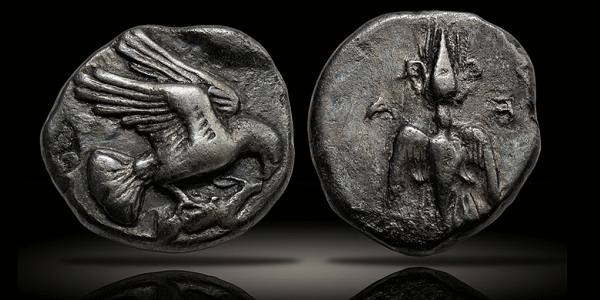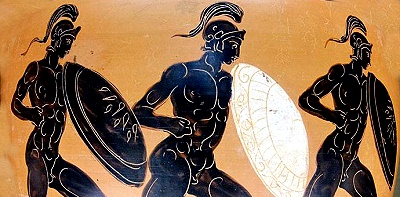
Ancient Olympics - Elis, Olympia, 87th-90th Olympiad, 432-420 BCE. AR Stater [1]
Coins of the Ancient Olympics by Russell A. Augustin - AU Capital Management, LLC ......
The Colosseo Collection ......
One of the few ancient traditions to survive until the modern world is the Olympic Games. Occurring in the same four-year cycle today as in antiquity, they mark a time when differences are put aside and the world’s attention focuses on athletic competition between nations.
The name “Olympics” originates from where they were played. Olympia was a sanctuary of ancient Greece near the city of Elis, a fertile country in the northwest of the Peloponnese. It featured temples, sporting grounds, and accommodations for the athletes. The inhabitants of Elis were responsible for organizing the games every four years. The stadium at Olympia seated no less than 45 thousand, and the publicity for the winners was immense.
These games were some of the most significant events of antiquity, even causing wars to be suspended for their duration. The classical Olympics date back to at least 776 BCE and were played until 394 CE when the Roman emperor Theodosius I abolished them, considering them to be too reminiscent of paganism. The modern games that began in Athens in 1896 featured 43 different events, steadily increasing to nearly 400 events today.
The ancient Olympics represented much more than just sporting events. They were a lucrative business and provided a political and cultural forum, offering a range of activities during the games. The athletes, their trainers, and the spectators needed to be housed, fed, and supplied with souvenirs. The games brought thousands of citizens together from all parts of the Greek world to visit the vast market and fairs, watch performances, and attend concerts.
From the fifth to the third century BCE, a magnificent series of special silver coins were minted from the festival center for each iteration of the Olympic Games, with new designs produced every four years.
The coinage for the games served several purposes. No foreign money was accepted in Elis during the games, and the mandatory exchange offered means of funding the games and for the upkeep of the sanctuary at Olympia. A common currency also made commerce easier as the native currencies of the various visitors were often based on different weight standards.
 The most talented artists were commissioned to engrave the dies for these coins, showing off the artistry of Greece and resulting in the beautiful coins being treated as prestigious objects. While their primary use was for normal commerce during the games (paying for food, lodging, and entry to see the spectacles), they became popular souvenirs for visitors who wanted to bring a part of the games home with them.
The most talented artists were commissioned to engrave the dies for these coins, showing off the artistry of Greece and resulting in the beautiful coins being treated as prestigious objects. While their primary use was for normal commerce during the games (paying for food, lodging, and entry to see the spectacles), they became popular souvenirs for visitors who wanted to bring a part of the games home with them.
These coins celebrated the god Zeus and his wife Hera, who presided over Olympia and the games themselves. The Olympic coinage is represented by a small range of imagery, focusing heavily on Zeus and his eagle, sometimes featuring snakes, thunderbolts, Ionic column capitals, or Nike, representing victory at the games.
Zeus’ portrait was used on some coins, modeled after the Statue of Zeus, which was one of the Seven Wonders of the Ancient World. It was also sufficient to use just an eagle or thunderbolt to refer to the god, as Zeus’ symbols were well known.
Eagles have always been a symbol of power, force, and guardianship because of their size, strong claws, and penetrating eyes. They were considered the kings of the air and certainly a fitting animal for Zeus, who presided over the sky and thunder.
The eagle on the obverse of this coin is acclaimed as the finest and most detailed representation of the head of an animal on any Greek coin. Magnificent in its composition and depicted with a great sense of naturalism, its elegance is in its simplicity, showing the strength of Zeus in the eagle’s forceful expression.
Below the eagle’s head is a leaf from the white-poplar tree brought from the northern lands to plant at Olympia. The white poplar was sacred to the mythological hero Hercules, and he was crowned with one of its branches as a token of his victory after destroying Cacus, a fire-breathing giant.

Elis, Olympia, 408 BCE. Zeus mint. Struck for the 93rd Olympaid. Silver Stater [2]
The reverse depicts a thunderbolt, in the usual stylized Greek fashion. While unsigned, it is understood that the die was engraved by the artist “Da” who signed the preceding, nearly identical die.
The coin is worn but appealing, showing clear evidence of its circulation at the Olympics. One can only imagine the wares purchased and sights seen by the spectators who spent it while in attendance at the 93rd Olympiad, more than 2,400 years ago.
[1] Elis, Olympia, 87th-90th Olympiad, 432-420 BCE. AR Stater (23mm, 11.51g, 9h). Eagle flying right with wings above his body, grasping hare by the back with his talons and tearing at him with his beak. Rev. F Thunderbolt with wings below and palmette with volutes above. BCD Olympia 53 var. Seltman 131 (BK/?d. SNG Cop 364 (= Seltman 131b). Rare. VF
[2] Elis, Olympia, 408 BCE. Zeus mint. Struck for the 93rd Olympaid. Silver Stater (11.74g). Head of an eagle with piercing eye left; under its beak, a large leaf of white-poplar. Reverse: Winged thunderbolt, olive sprigs to right and left; all within an olive-leaf border. Seltman 150; Traite pl. 231, 1 (these dies) . Kraay-Himer pl. 157, 500 (this obverse die) ; Gulbenkian 541 (this obverse die) ; Weber 4038. One of the masterpieces of Greek coinage and the most realistic close-up of an animal depicted on any Greek coin. Lightly toned and of good metal. Very Fine.





Is this coin for sale?
I don’t think so but contact Russell Augustin at [email protected] or (407)352-3966
Do you have a complete list of all the ancient coins that were issued for the Olympics or issued to honor Olympic winners? …is there any book on this subject? Thanks!!